I'm trying to get the Google Maps Javascript API to take points from a JSON and use the computeOffset() function to calculate points left and right so that I can plot a path using polygons. My current code seems to only be making strange shapes instead of making clean polygon connections from point to point.
I'm defining var lastPoint as the lastPoint from the jQuery $.each loop so that when the query goes to the next lat lng value the polygon will connect to the previous point. Instead of nice square polygons from point to point I'm getting weird shapes, mainly triangles instead of squares.
$.getJSON('sixth.json', function(data) {
var lastPoint;
var myLatlng2;
var polyShape;
$.each( data.contactdetails, function(i, value) {
myLatlng2 = new google.maps.LatLng(value.lat, value.lng);
var boomwidth = value.boomwidth;
var bear = value.bear;
var boomconversionfactor = 1;
//computeOffset returns a LatLng position by using the bearing and number of feet to return another location
var point1 = google.maps.geometry.spherical.computeOffset(myLatlng2, (0.30480 * boomwidth * boomconversionfactor) / 2, bear + 90);
var point2 = google.maps.geometry.spherical.computeOffset(myLatlng2, (0.30480 * boomwidth * boomconversionfactor) / 2, bear - 90);
var point3 = google.maps.geometry.spherical.computeOffset(myLatlng2, (0.30480 * boomwidth * boomconversionfactor) / 2, 90 + bear);
var point4 = google.maps.geometry.spherical.computeOffset(myLatlng2, (0.30480 * boomwidth * boomconversionfactor) / 2, bear - 90);
if (lastPoint !== undefined){
var point1 = google.maps.geometry.spherical.computeOffset(lastPoint, (0.30480 * boomwidth * boomconversionfactor) / 2, bear + 90);
var point2 = google.maps.geometry.spherical.computeOffset(lastPoint, (0.30480 * boomwidth * boomconversionfactor) / 2, bear - 90);
}
var Coords = [point1,point2, point3, point4];
// Construct the polygon.
polyShape = new google.maps.Polygon({
paths: Coords,
strokeColor: '#FF0000',
strokeOpacity: 0.8,
strokeWeight: 2,
fillColor: '#FF0000',
fillOpacity: 0.35
});
polyShape.setMap(map);
//assign lastPoint the lat lng value from the jQuery loop. Trying to connect previous position to next by placing the lastPoint outside the loop.
lastPoint = myLatlng2;
}); //close of .each jQuery loop
});
This is what the json contains. When I use an alert or plot with markers the locations show up correctly on the map.
Here is an image. Instead of cleanly closing the polygons I'm getting these triangular shaped pieces.

